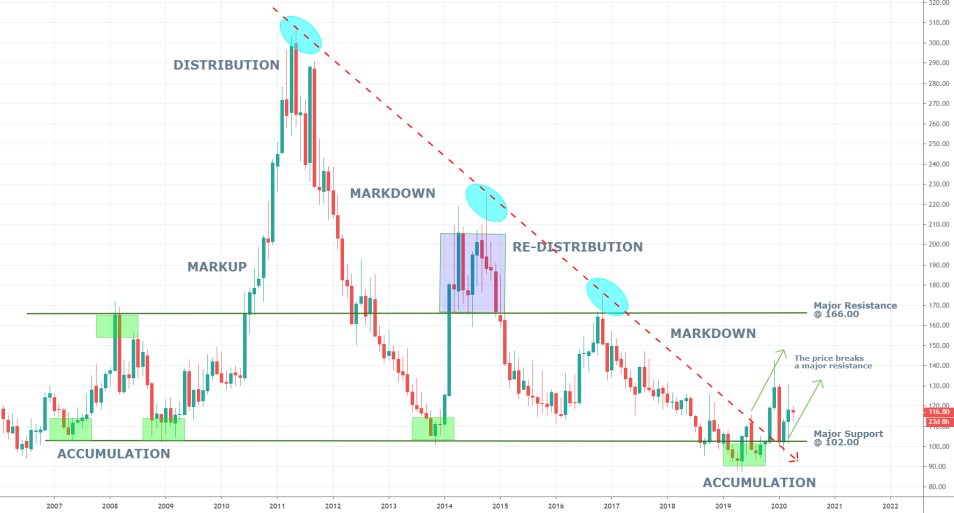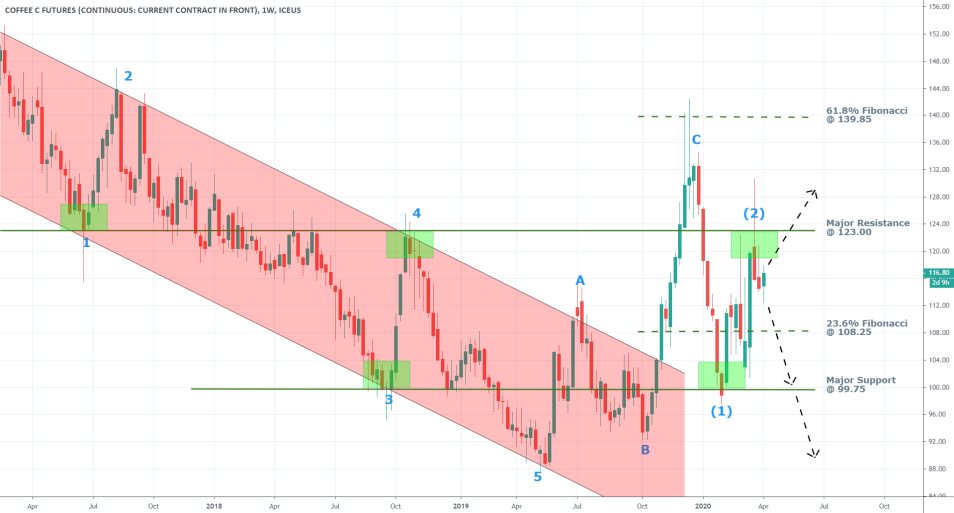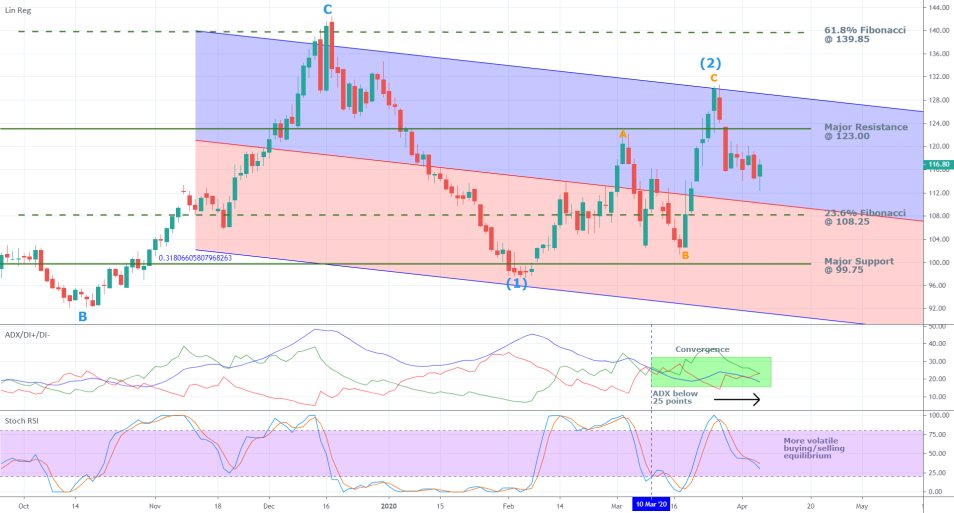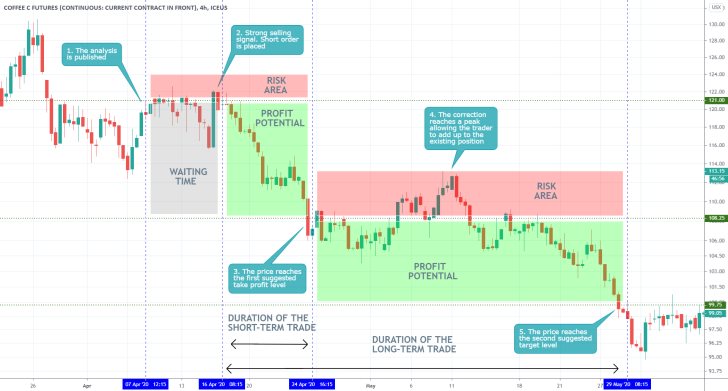Coffee futures are currently trading at the lower end of a major bearish trend, which prompts some market analysts to expect the underlying market sentiment to change soon. The price action has already broken out above a few key resistance levels, which some traders perceive as early indications suggesting the increasing bullish commitment in the market.
Since we are talking about a significant transformational change in the market sentiment that has been developing for nearly a decade, such a move would be conceivable only if the underlying supply and demand equilibrium was to change as well.
In one of our previous market insights, we argued that the international lockdowns and policies of social distancing, currently implemented by governments and individuals alike, could have a profound impact on the way coffee is sold by businesses and enjoyed by individuals. Such idiosyncratic changes do not relate merely to the financial aspect of coffee distribution worldwide, but also postulate a significant variation in the way individuals enjoy the drink – at home for leisure as opposed to on the way to work.
All of these developments could indeed have a profound impact on the supply and demand pressures in the market for coffee, and the current pandemic could serve as a catalyst for the first major alteration in the underlying market sentiment. Consequently, the price action of coffee futures could be entering into a new stage of development at present – a transition from bearish to a bullish market.
Such a change would, of course, be gradual and take a long time to develop, almost undetectable for day traders. Nevertheless, it would be worthwhile to examine the nature of these changing market pressures, so that traders can be well-aware of the currently evolving new market conditions. Thereby, today's analysis sets out to examine both the short term and long term price action of coffee futures and to underscore the most likely future tendencies of its development.
1. Long Term Outlook:
The monthly chart below illustrates the aforementioned changing market sentiment for the world benchmark of Arabica coffee, with a commodity code KC. The current market price is 116.80 cents (1.16 dollars) per contract, which is where the until recently prevailing selling pressure seems to have started to diminish.
The bearish market began in April of 2011 (exactly nine years ago) at the psychologically critical threshold of 300 cents per contract. The lower end of the bearish downswing was reached close to another psychologically-fused price level at 100 cents per contract (the price action fell even lower than that below it rebounded).
As can be seen on the chart below, the bearish market did not evolve in a straightforward channel but rather fluctuated in intermittent periods characterised by markdowns, markups, and distributions.

Two major technical factors might be pointing to the likely transition of coffee futures into a bullish market. The first factor relates to the behaviour of the price action around the major support level at 102.00. It has consolidated above the support level after having previously formed a false breakdown below it. Such behaviour entails the classic transition from bearish to bullish market conditions.
Moreover, there are two distinctive Markdowns on the chart above, with the second one being more fractured than the first one. The slope of the falling price has gradually become less steep, compared with the first massive dropdown, which took place in early 2012. This behaviour of the price action is illustrative of waning bearish commitment in the market.
The second factor relates to the behaviour of the price action around the downwards sloping red arrow, which underscores the three major peaks of the bearish market. The three blue ellipses highlight these. Since the last one was formed when the price bounced back from the major resistance level at 166.00, the former Markdown started threading very close to that red arrow. This behaviour of the price action was exhibitive of waning strength in the bearish market even before the new Accumulation range started forming.
Until that point, the red arrow was serving as a downwards sloping resistance level. Once the price managed to break out above it in November of 2019, the structure of the bearish market was also decidedly broken. This does not mean that future dropdowns are impossible to occur in the midterm, but instead, this behaviour of the price action seems to confirm the aforementioned transition of the market into a new stage. The currently forming Accumulation range is demonstrative of the presently ongoing build-up of buying pressure in the market. This recent development, in turn, can be explained by a closer examination of the underlying fundamentals in the market.
2. Brazilian President Jair Bolsonaro and his Stance on the Coronavirus:
To understand the key developments in the global supply and demand equilibrium for Arabica coffee, one has to be aware of the current geopolitical landscape in Brazil, which is the biggest producer of the commodity.
The coronavirus pandemic, which has already disrupted the normal operations of so many markets as well as people’s daily lives, is also affecting the market for Arabica coffee in its entirety – from production through exports down to consumption. There are several crucial factors concerning Brazil, which require close attention:
“Brazil is the world’s largest producer of coffee. The country produces approximately a third of the world’s total coffee. Brazil is also the world’s largest exporter of coffee despite its large domestic coffee consumption. Brazil’s coffee is the driving force of Brazil’s economy. In 2015/2016 Brazil produced 2,592,000 metric tons of coffee. The export value of coffee in Brazil is 5.08 billion dollars. Brazil is unrivalled in the production of Arabica, green coffee, and instant coffee. The largest markets for Brazilian coffee are Japan, the United States, and Europe.”
All of these factors point to the importance of coffee production for the Brazilian economy, as well as the Brazilian coffee-production industry for the global supply of the commodity. In that sense, understanding the economic consequences from the coronavirus fallout on Brazil is going to shed light on the likely future development of the supply and demand equilibrium of coffee.
Brazil is currently on national lockdown in a bid to curtail the spread of the virus, which is also indirectly affecting the immediate production of coffee. This impediment is likely to be reflected in the next several weeks’ global shipping. Naturally, the longer that the lockdown is in effect, the longer that this impediment to production is going to persist. Subsequently, as production continues to fall, the price is likely to rise.
On the other hand, Brazilian President Jair Bolsonaro has attempted to downplay the healthcare risks from the virus by labelling it “little flew”, and arguing that Brazilians are immune to the pathogen because they are used to jumping sewers. Bolsonaro remains the only prominent world leader who maintains his scepticism on the magnitude of the pandemic. Meanwhile, Boris Johnson, the British Prime Minister, was admitted to the ICU yesterday as his COVID-19 symptoms worsened.
Bolsonaro has continuously praised the spirits of Brazilians and urged them to return to work so that they can save the reeling national economy. Two potential scenarios can unfold from here on out. One possibility is the President’s pleas are ignored by the public, on which case the production of coffee continues to be subdued over the foreseeable future, and prices start to rise on supply concerns.
Alternatively, Bolsonaro manages to convince a significantly considerable portion of the population the risks are marginal, on which case they return to work and the coffee industry is temporarily stabilised. Under such circumstances, however, the already fragile Brazilian healthcare system is likely to be quickly overwhelmed by rapidly rising new cases of the disease. Subsequently, the broader economy starts feeling strain from the negative spillover effect that is prompted by the increasing number of infected people.
In the second scenario, the coffee industry is again going to be impacted negatively by the virus, albeit the effect is going to take longer to unfold. Ultimately, the coronavirus pandemic is going to distort Brazil’s coffee production and exports regardless of the way in which the country chooses to proceed from here on. The only noticeable difference is going to be in the time it takes the industry to recover.
In the first case, the hit on the industry is going to be sudden and massive in the short run. In the second case, the economic blow is going to be less pronounced and develop more gradually, but it would also affect the industry for much longer. In both instances, Brazil's coffee exports are likely to suffer losses in Q2 and Q3, which, in turn, is going to decrease the global supply and likely prompt a price hike of coffee futures.
3. Short Term Outlook:
As can be seen on the weekly chart below, Elliott Wave Theory is utilised to break down the behaviour of the price action since the beginning of the Accumulation’s establishment.

The bearish market was terminated once the 1-5 impulse wave pattern reached a bottom at point 5. Afterwards, a corrective ABC pattern was established, which rebounded from the 61.8 per cent Fibonacci retracement level at 139.82 - a prominent resistance level. Later, the price fell to the major support level at 99.75, which can be interpreted in one of two ways.
Either, the price action has already started forming a new significant bearish 1-5 pattern (as indicated by the potential (1)-(2) pullback on the chart above), or the price is consolidating around the psychologically important range around 100 cents per contract before the new bullish sentiment starts driving the price action further north.
The price is currently consolidating within the aforementioned Accumulation range, which has the major resistance level at 123.00 for its upper boundary and the major support level at 99.75 for its lower edge. A successful breakout or breakdown outside of the range is going to provide a decisive confirmation of the price action’s future behaviour.

The ADX on the daily chart above is currently threading below 25 points, which is confirming the existence of the aforementioned Accumulation range. A peculiar thing to notice is the tight consolidation of the ADX alongside the D+ and the D-. Such behaviour is typically associated with the relative ‘calmness’ of the market before the price action begins establishing a new significant directional swing. This assertion is inlined with our expectation for an upcoming breakout or breakdown.
The RSI oscillator is currently displaying a relative balance between the selling and buying demand pressures in the short term, which means that the most recent swing can continue going south in the foreseeable future before the market becomes ‘Oversold’. Keep in mind that in range-trading environments, such as the case with Accumulations and Distributions, oscillators are especially helpful for determining the snap changes in the underlying demand pressures.
Hence, the twists and turns of the RSI are likely to become more intuned with the sudden upswings and downswings that are to be expected to form in the foreseeable future. At any rate, that is to be anticipated for as long as the price action continues threading within the boundaries of the Accumulation range.
Finally, the regression channel’s middle line is currently coinciding with the 23.6 per cent Fibonacci retracement at 108.25 and the support level there. This makes it a more significant and pronounced price level.
4. Concluding Remarks:
Overall, coffee futures seem ready to start trading in a new long-term bullish trend. This expectation is supported by the behaviour of the price action as well as the underlying fundamental factors. Nevertheless, this should not be interpreted as a straightforward buying signal!
Such broad market developments usually take a long time to evolve, and with that, the alterations in the underlying market conditions are much more gradual. Consequently, traders should be prepared to expect the formation of potential dropdowns in the price action to the psychological support level at 100 cents per contract (perhaps even lower), as part of the transitionary process’s development.

- The bullish uptrend of the coffee futures was not resumed in the mid-term because the underlying fundamentals were not interpreted correctly. Nevertheless, the technical portion of the analysis was perfect, which allowed for the execution of two very profitable trades. Interesting to point out that the resulting downtrend consolidated just below the 100.00 level, which bears considerable psychological significance. One should always monitor the behaviour of the price action around such psychological supports and resistances, as these are very often serving as prominent turning points.
Disclaimer: Your capital is at risk! Trading and investing on the financial markets carries a significant risk of loss. Each material, shown on this website, is provided for educational purposes only. A perfect, 100% accurate method of analysis does not exist. If you make a decision to trade or invest, based on the information from this website, you will be doing it at your own risk. Under no circumstances is Trendsharks responsible for any capital losses or damages you might suffer, while using the company’s products and services. For more information read our Terms & Conditions and Risk Disclaimer.





















